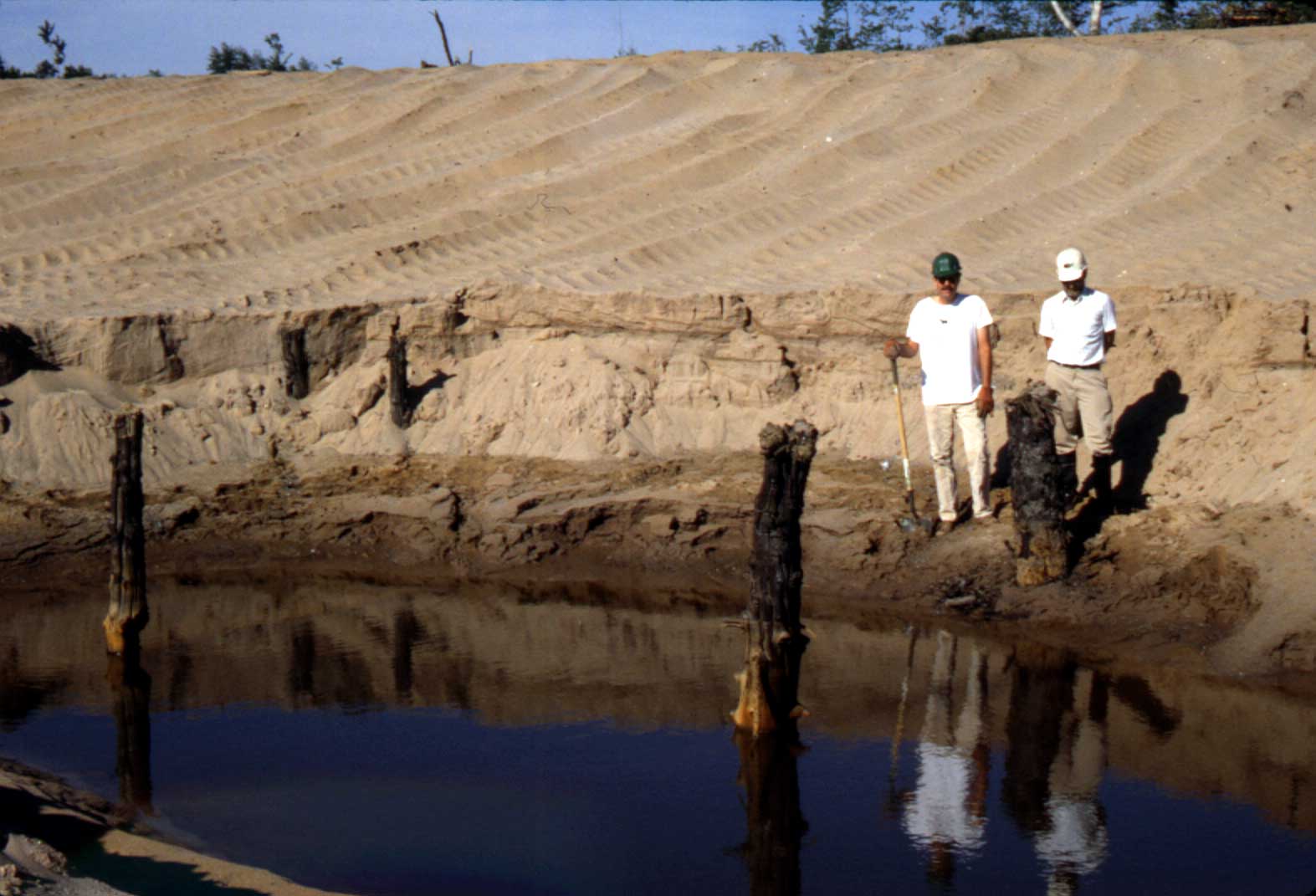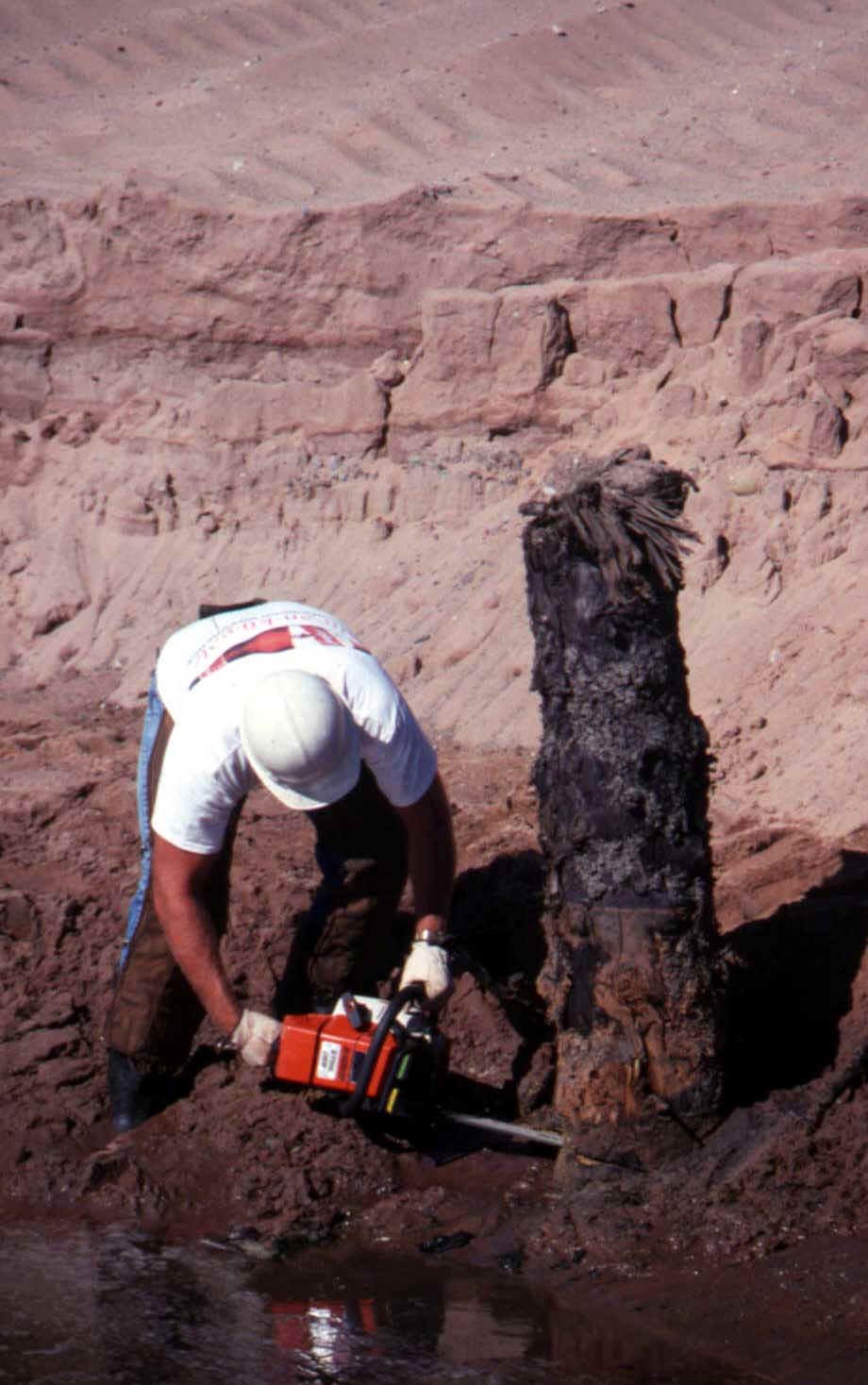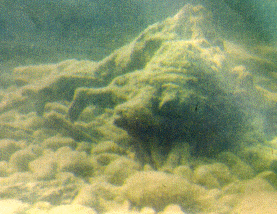GLACIAL LAKES CHIPPEWA AND STANLEY
Lake Chippewa and Stanley formed as the North Bay outlet in Canada was exposed (as the ice
withdrew from it). This very low, isostatically-depressed outlet allowed the waters
of Glacial Lake Algonquin to drain rapidly out to
the east, lowering the water levels in the Lake Michigan-Huron basin over 300 feet.
The "plug was pulled" about 10,000 years BP.
We know a lot about the Marquette readvance because it buried a forest bed at Gribben
Lake. These trees have been dated with radiocarbon methods and have been shown to be
about 10,000 years old. In 1999, another buried forest bed was discovered several
miles to the east of Gribben Lake. Michigan Tech researchers unearthed the trees,
many of which were standing in place. Here's part of that story:
About 10,000 years ago, as Ice Age glaciers thawed in what is
now Michigan, a forest of spruce trees sprouted and flourished. Then, quickly, the forest
died. Preserved in rising water and sand, the ancient trees are giving scientists a
remarkable look at the last time the world’s climate warmed rapidly and may offer
compelling lessons for the present, when most experts believe the Earth is warming again.
Preliminary analysis of the tree rings suggests, for example, that sudden changes
in climate may not always be detectable in advance.
Scientists at Michigan Technological University learned of the
discovery, at a nearby site where sand was being mined, by accident. According to
Theodore Bornhorst, of the university’s Department of Geological Engineering and
Science, a professor overheard workers
talking about uncovering some buried trees. Scientists and students rushed to the site to
find the tops of the trees sticking out of the sand pit, and the race was on to recover at
least some of the trees before they were destroyed. Earthen dikes were built to keep water
from flooding
the excavation as researchers carefully removed the sand. What they found was astonishing:
five acres of ancient forest, still standing and nearly perfectly preserved, down to the
moss on the limbs of the trees.
“It looks very much like a forest you would find today near Hudson
Bay,” says Professor Kurt Pregitzer of the university’s Forestry Department.
Fossilized vegetation from the same era has been found in the region before, but a
standing forest and a complete ecological system gives scientists a unique opportunity to
see just what was happening with the climate when nature dropped the curtain on the
forest.
The trees began to grow as soon as the glacier retreated north past the site, and the
glacier was probably no more than five or 10 miles away
when the most mature trees reached their tallest height of 30 feet. But a sudden
shift toward warmer temperatures accelerated melting of the
glacier, flooding the area with water. The standing water probably killed the trees,
some of which were about 145 years old, but the silt preserved the needles and cones lying
on the forest floor. If the process had ended there, the trees would have rotted,
according to Bornhorst, but then a curious thing happened. The climate apparently
changed again, probably even greater warming, sending more water into the forest. The
water carried along fine sand ground up by the retreating glacier, which quickly buried
the trees. But not so quickly as to knock the trees down. “It had to have been a very
rapid but gentle burial,” Bornhorst says, because even tiny “limblets” of
new growth survived the process.
As students and professors worked side by side to keep the water out of the pit,
researchers with chain saws collected 140 cross-sections of
the trees. But in a few days the dikes began to give way, and water was allowed to reflood
the area, reburying the trees. Miners returned to excavate the sand, a process that
destroyed what remained of the ancient forest. “It’s gone now,” Pregitzer
says.
Here are some images from this site.


While the Great Lakes' levels were low, you now know that forests grew on the dry, exposed
lake beds. Here's an excerpt from a study about a shipwreck diving expedition that
came upon such a "drowned" forest in Lake Superior. Recall that Lake
Superior had a low phase similar to the one that occurred in Lakes Michigan-Huron.
However, the low phase in Lake Superior (named the Houghton low phase)
was shorter lived.
The Forest From 6,000 BC
When Captain Peter Lindquist discovered a prehistoric forest
almost 200 feet under Lake Superior, he was amazed. Capt. Lindquist became excited
when his depth finder showed what appeared to be masts standing up off the bottom in 180
feet of water. Gearing up with double tanks, he and his partner started down on their very
deep dive with high expectations of dropping onto a shipwreck standing intact on the
bottom. Instead of masts, however, they found themselves among several tall trees standing
upright on the lake bottom! "Upright on the lake floor, the
trees were one to two feet in diameter and perhaps 15 to 20 feet high, with branches
intact. Sitting on the bottom, it was like looking up through maples" Though he never
left the dive line, Captain Lindquist saw at least five trees at the site (see image
below).

Another mysterious tree was found amid the wreckage of the wooden
freighter HERMAN H. HETTLER in Munising's East Channel. Suspecting that the tree was
extremely old, Captain Pete Lindquist sent samples of the wood for carbon dating. The
laboratory results showed an age of 7,910 years plus or minus l00 years, but provided no
clue as to why a nearly 8,000 year old tree would be found amid the remains of a 1926
shipwreck.
Where did these trees come from ?
It is probable that thousands of years ago when the lake level was
lower, the trees actually grew where they now stand. A parallel might be drawn with the
Gribben Forest, a stand of 10,000 year old spruce trees uncovered during the excavation of
a tailings basin for the Tilden Mine in Marquette County. Some of the Gribben trees were
still standing where they had grown and had been buried by sand and silt washed out from a
melting glacier at the end of the last Ice Age. During the Ice Age, the Great Lakes, as
well as the oceans, were believed to have been much lower than present levels due to the
tremendous amount of water frozen in the glaciers that covered much of the continents. The
trees might have grown on the southern shores of a smaller, shallower Lake Superior and
drowned when the lake level rose with the melting of the glaciers.
This material has been compiled for educational use only, and may not be reproduced without permission. One copy may be printed for personal use. Please contact Randall Schaetzl (soils@msu.edu) for more information or permissions.